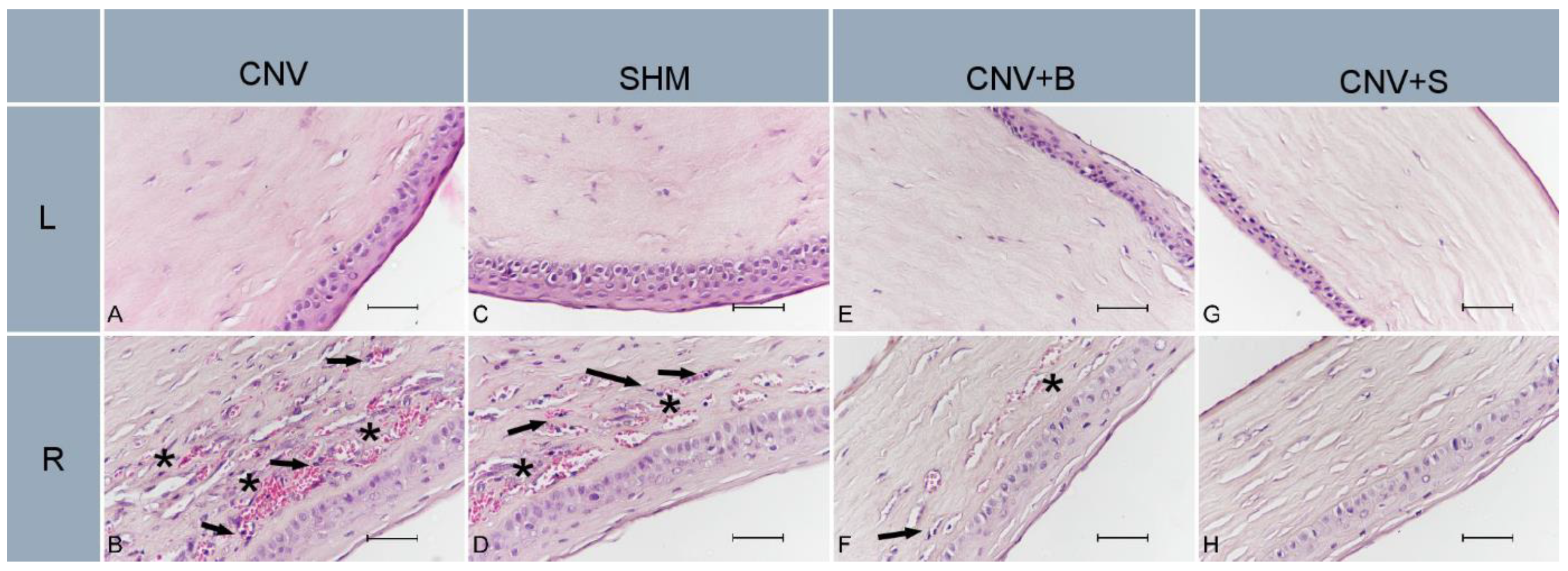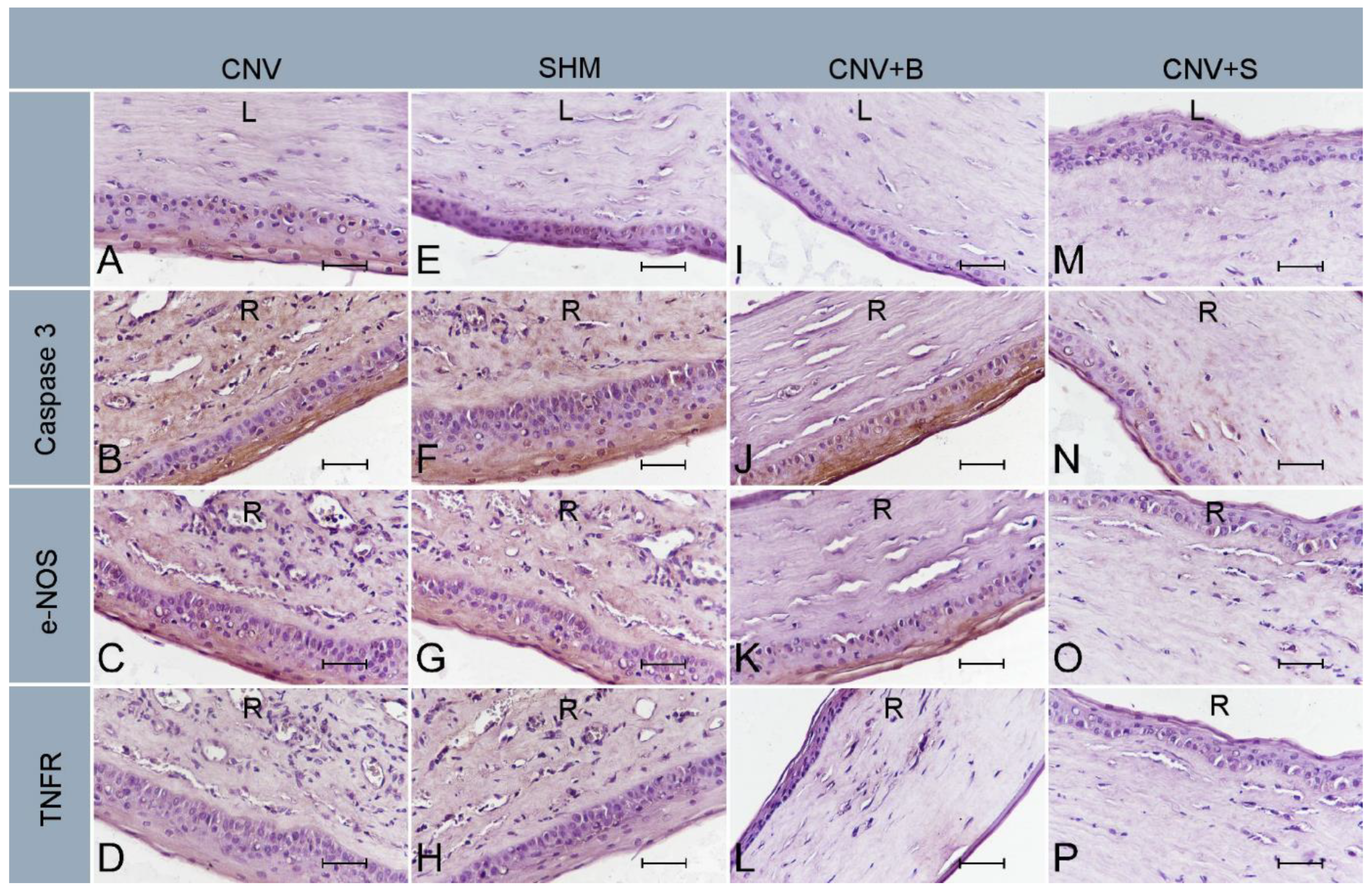Salubrinal Ameliorates Inflammation and Neovascularization via the Caspase 3/Enos Signaling in an Alkaline-Induced Rat Corneal Neovascularization Model
Abstract
1. Introduction
2. Materials and Methods
2.1. Animals
2.2. CNV Model and Experimental Design
2.3. Hematoxylin Eosin Staining
2.4. Immunohistochemistry
2.5. Statistical Analyzes
3. Results
3.1. Histopathology
3.2. Immunohistochemistry
4. Discussion
5. Conclusions
Author Contributions
Funding
Institutional Review Board Statement
Informed Consent Statement
Data Availability Statement
Conflicts of Interest
References
- Wagoner, M.D. Chemical injuries of the eye: Current concepts in pathophysiology and therapy. Surv. Ophthalmol. 1997, 41, 275–313. [Google Scholar] [CrossRef] [PubMed]
- Kubota, M.; Shimmura, S.; Kubota, S.; Miyashita, H.; Kato, N.; Noda, K.; Ozawa, Y.; Usui, T.; Ishida, S.; Umezawa, K.; et al. Hydrogen andN-Acetyl-l-Cysteine Rescue Oxidative Stress-Induced Angiogenesis in a Mouse Corneal Alkali-Burn Model. Investig. Opthalmol. Vis. Sci. 2011, 52, 427–433. [Google Scholar] [CrossRef] [PubMed]
- Zhang, H.; Wang, Z.-W.; Wu, H.-B.; Li, Z.; Li, L.-C.; Hu, X.-P.; Ren, Z.-L.; Li, B.-J.; Hu, Z. Transforming growth factor-β1 induces matrix metalloproteinase-9 expression in rat vascular smooth muscle cells via ROS-dependent ERK–NF-κB pathways. Mol. Cell. Biochem. 2013, 375, 11–21. [Google Scholar] [CrossRef] [PubMed]
- Minamino, T.; Komuro, I.; Kitakaze, M. Endoplasmic Reticulum Stress as a Therapeutic Target in Cardiovascular Disease. Circ. Res. 2010, 107, 1071–1082. [Google Scholar] [CrossRef] [PubMed]
- Sanderson, T.H.; Gallaway, M.; Kumar, R. Unfolding the Unfolded Protein Response: Unique Insights into Brain Ischemia. Int. J. Mol. Sci. 2015, 16, 7133–7142. [Google Scholar] [CrossRef] [PubMed]
- Rutkowski, D.T.; Kaufman, R.J. That which does not kill me makes me stronger: Adapting to chronic ER stress. Trends Biochem. Sci. 2007, 32, 469–476. [Google Scholar] [CrossRef] [PubMed]
- Tian, X.-S.; Xu, H.; He, X.-J.; Li, Y.; He, B.; Zhao, D. Endoplasmic reticulum stress mediates cortical neuron apoptosis after experimental subarachnoid hemorrhage in rats. Int. J. Clin. Exp. Pathol. 2020, 13, 1569. [Google Scholar] [PubMed]
- Han, Y.; Yuan, M.; Guo, Y.S.; Shen, X.Y.; Gao, Z.K.; Bi, X. Mechanism of Endoplasmic Reticulum Stress in Cerebral Ischemia. Front. Cell Neurosci. 2021, 15, 704334. [Google Scholar] [CrossRef]
- Gupta, S.; Biswas, J.; Gupta, P.; Singh, A.; Tiwari, S.; Mishra, A.; Singh, S. Salubrinal attenuates nitric oxide mediated PERK:IRE1α: ATF-6 signaling and DNA damage in neuronal cells. Neurochem. Int. 2019, 131, 104581. [Google Scholar] [CrossRef]
- Senol, N.; Oguzoglu, A.S.; Erzurumlu, Y.; Ascı, H.; Savran, M.; Gulle, K.; Ilhan, I.; Sadef, M.; Hasseyid, N.; Goksel, H.M. Modulation of Salubrinal-Mediated Endoplasmic Reticulum Stress in an Experimental Subarachnoid Hemorrhage Model. World Neurosurg. 2021, 153, e488–e496. [Google Scholar] [CrossRef]
- Guzel, E.; Basar, M.; Ocak, N.; Arici, A.; Kayisli, U.A. Bidirectional Interaction Between Unfolded-Protein-Response Key Protein HSPA5 and Estrogen Signaling in Human Endometrium1. Biol. Reprod. 2011, 85, 121–127. [Google Scholar] [CrossRef]
- Wang, Y.; Alam, G.N.; Ning, Y.; Visioli, F.; Dong, Z.; Nör, J.E.; Polverini, P.J. The Unfolded Protein Response Induces the Angiogenic Switch in Human Tumor Cells through the PERK/ATF4 Pathway. Cancer Res. 2012, 72, 5396–5406. [Google Scholar] [CrossRef]
- Pereira, E.; Frudd, K.; Awad, W.; Hendershot, L.M. Endoplasmic Reticulum (ER) Stress and Hypoxia Response Pathways Interact to Potentiate Hypoxia-inducible Factor 1 (HIF-1) Transcriptional Activity on Targets Like Vascular Endothelial Growth Factor (VEGF). J. Biol. Chem. 2014, 289, 3352–3364. [Google Scholar] [CrossRef]
- Hu, Y.; Lu, X.; Xu, Y.; Lu, L.; Yu, S.; Cheng, Q.; Yang, B.; Tsui, C.-K.; Ye, D.; Huang, J.; et al. Salubrinal attenuated retinal neovascularization by inhibiting CHOP-HIF1α-VEGF pathways. Oncotarget 2017, 8, 77219–77232. [Google Scholar] [CrossRef]
- Chen, J.-H.; Wu, C.-H.; Chiang, C.-K. Therapeutic Approaches Targeting Proteostasis in Kidney Disease and Fibrosis. Int. J. Mol. Sci. 2021, 22, 8674. [Google Scholar] [CrossRef] [PubMed]
- Sepúlveda-Fragoso, V.; Alexandre-Santos, B.; Salles, A.C.P.; Proença, A.B.; Alves, A.P.D.P.; Vázquez-Carrera, M.; Nóbrega, A.C.L.; Frantz, E.D.C.; Magliano, D.C. Crosstalk between the renin-angiotensin system and the endoplasmic reticulum stress in the cardiovascular system: Lessons learned so far. Life Sci. 2021, 284, 119919. [Google Scholar] [CrossRef] [PubMed]
- Mahoney, J.M.; Waterbury, L.D. Drug effects on the neovascularization response to silver nitrate cauterization of the rat cornea. Curr. Eye Res. 1985, 4, 531–535. [Google Scholar] [CrossRef] [PubMed]
- Karaca, U.; Savran, M.; Usta, G.; Gulle, K.; Nihan, F.; Ascı, H. Can endoplasmic reticulum stress inhibition reduce inflammation due to alkaline corneal burns? Preliminary Report. J. Glaucoma Cataract. 2021, 16, 167. [Google Scholar] [CrossRef]
- Ozdemir, O.; Altintas, O.; Altintas, L.; Ozkan, B.; Akdag, C.; Yüksel, N. Comparison of the effects of subconjunctival and topical anti-VEGF therapy (bevacizumab) on experimental corneal neovascularization. Arq. Bras. Oftalmol. 2014, 77, 209–213. [Google Scholar] [CrossRef]
- Ayatollahi, H.; Sharifi, N.; Sadeghian, M.H.; Alenabi, A.; Ghasemian-Moghadam, H.R. Immunohistochemical expression of apoptosis regulators in squamous cell carcinoma of the cervix and their association with human papillomavirus 16/18 subtypes. Balkan Med. J. 2014, 31, 202–207. [Google Scholar] [CrossRef]
- Detre, S.; Jotti, G.S.; Dowsett, M. A “quickscore” method for immunohistochemical semiquantitation: Validation for oestrogen receptor in breast carcinomas. J. Clin. Pathol. 1995, 48, 876–878. [Google Scholar] [CrossRef] [PubMed]
- Ljubimov, A.V.; Saghizadeh, M. Progress in corneal wound healing. Prog. Retin. Eye Res. 2015, 49, 17–45. [Google Scholar] [CrossRef] [PubMed]
- Cnop, M.; Foufelle, F.; Velloso, L.A. Endoplasmic reticulum stress, obesity and diabetes. Trends Mol. Med. 2012, 18, 59–68. [Google Scholar] [CrossRef] [PubMed]
- Chen, X.; Wang, J.; Gao, X.; Wu, Y.; Gu, G.; Shi, M.; Chai, Y.; Yue, S.; Zhang, J. Tauroursodeoxycholic acid prevents ER stress-induced apoptosis and improves cerebral and vascular function in mice subjected to subarachnoid hemorrhage. Brain Res. 2020, 1727, 146566. [Google Scholar] [CrossRef] [PubMed]
- Wang, Y.; Wang, L.; Guo, H.; Peng, Y.; Nie, D.; Mo, J.; Ye, L. Knockdown of MALAT1 attenuates high-glucose-induced angiogenesis and inflammation via endoplasmic reticulum stress in human retinal vascular endothelial cells. Biomed. Pharmacother. 2020, 124, 109699. [Google Scholar] [CrossRef]
- Wang, Y.; Gao, S.; Gao, S.; Na Li, N.; Xie, B.; Shen, X. Blocking the interaction between interleukin-17A and endoplasmic reticulum stress in macrophage attenuates retinal neovascularization in oxygen-induced retinopathy. Cell Biosci. 2021, 11, 82. [Google Scholar] [CrossRef]
- Wang, Y.-C.; Li, X.; Shen, Y.; Lyu, J.; Sheng, H.; Paschen, W.; Yang, W. PERK (Protein Kinase RNA-Like ER Kinase) Branch of the Unfolded Protein Response Confers Neuroprotection in Ischemic Stroke by Suppressing Protein Synthesis. Stroke 2020, 51, 1570–1577. [Google Scholar] [CrossRef]
- Pakos-Zebrucka, K.; Koryga, I.; Mnich, K.; Ljujic, M.; Samali, A.; Gorman, A.M. The integrated stress response. EMBO Rep. 2016, 17, 1374–1395. [Google Scholar] [CrossRef]
- Chu, H.-S.; Peterson, C.; Chamling, X.; Berlinicke, C.; Zack, D.; Jun, A.S.; Foster, J. Integrated Stress Response Regulation of Corneal Epithelial Cell Motility and Cytokine Production. Investig. Opthalmology Vis. Sci. 2022, 63, 1. [Google Scholar] [CrossRef]
- Lu, P.D.; Harding, H.; Ron, D. Translation reinitiation at alternative open reading frames regulates gene expression in an integrated stress response. J. Cell Biol. 2004, 167, 27–33. [Google Scholar] [CrossRef]
- Zadorozhnii, P.V.; Kiselev, V.V.; Kharchenko, A.V. In silico toxicity evaluation of Salubrinal and its analogues. Eur. J. Pharm. Sci. 2020, 155, 105538. [Google Scholar] [CrossRef] [PubMed]
- Chen, S.; Sun, C.; Gu, H.; Wang, H.; Li, S.; Ma, Y.; Wang, J. Salubrinal protects against Clostridium difficile toxin B-induced CT26 cell death. Acta Biochim. Biophys. Sin. 2017, 49, 228–237. [Google Scholar] [CrossRef]
- Matsuoka, M.; Komoike, Y. Experimental Evidence Shows Salubrinal, an eIF2α Dephosphorylation Inhibitor, Reduces Xenotoxicant-Induced Cellular Damage. Int. J. Mol. Sci. 2015, 16, 16275–16287. [Google Scholar] [CrossRef] [PubMed]
- Chodari, L.; Aytemir, M.D.; Vahedi, P.; Alipour, M.; Vahed, S.Z.; Khatibi, S.M.H.; Ahmadian, E.; Ardalan, M.; Eftekhari, A. Targeting Mitochondrial Biogenesis with Polyphenol Compounds. Oxidative Med. Cell. Longev. 2021, 2021, 4946711. [Google Scholar] [CrossRef] [PubMed]
- Vallabh, N.A.; Romano, V.; Willoughby, C.E. Mitochondrial dysfunction and oxidative stress in corneal disease. Mitochondrion 2017, 36, 103–113. [Google Scholar] [CrossRef]
- Chang, J.-H.; Garg, N.K.; Lunde, E.; Han, K.-Y.; Jain, S.; Azar, D.T. Corneal Neovascularization: An Anti-VEGF Therapy Review. Surv. Ophthalmol. 2012, 57, 415–429. [Google Scholar] [CrossRef]
- Gupta, A.A.; Mammo, D.A.; Page, M.A. Intrastromal bevacizumab in the management of corneal neovascularization: A retrospective review. Graefe’s Arch. Clin. Exp. Ophthalmol. 2020, 258, 167–173. [Google Scholar] [CrossRef]
- TNF Signaling Pathway. Available online: https://www.kegg.jp/pathway/map04668 (accessed on 25 December 2022).
- VEGF Signaling Pathway. Available online: https://www.kegg.jp/entry/map04370 (accessed on 25 December 2022).
- Apoptosis. Available online: https://www.kegg.jp/pathway/map04215 (accessed on 25 December 2022).



| CNV-L | CNV-R | SHAM-L | SHAM-R | BVC-L | BVC-R | SLB-L | SLB-R | |
|---|---|---|---|---|---|---|---|---|
| Neovascularization | 1.2 ± 0.4 | 3.8 ± 0.4 | 1.2 ± 0.4 | 3.6 ± 0.5 # | 1.2 ± 0.4 | 2.2 ± 0.4 *** | 1.2 ± 0.4 | 2.0 ± 0.7 *** |
| Inflammatory Cell Infiltration | 1.2 ± 0.4 | 3.6 ± 0.5 | 1.2 ± 0.4 | 3.4 ± 0.5 # | 1.2 ± 0.4 | 2.2 ± 0.4 ** | 1.2 ± 0.4 | 2.2 ± 0.4 ** |
| Fibroblast Activity | 1.2 ± 0.4 | 2.8 ± 0.4 | 1.2 ± 0.4 | 2.6 ± 0.5 # | 1.2 ± 0.4 | 1.6 ± 0.5 ** | 1.2 ± 0.4 | 1.4 ± 0.5 ** |
| CNV-L | CNV-R | SHAM-L | SHAM-R | BVC-L | BVC-R | SLB-L | SLB-R | ||
|---|---|---|---|---|---|---|---|---|---|
| CASPASE-3 | Med. (Q25-Q75) | 0(0–1) | 9(9–12) * | 0(0–0.5) | 9(6–10.5) *,# | 0(0–1) | 1(0–1) ** | 0(0–0) | 0(0–0.5) ** |
| Min. | 0 | 9 | 0 | 6 | 0 | 0 | 0 | 0 | |
| Max | 1 | 12 | 1 | 12 | 1 | 0 | 0 | 1 | |
| e-NOS | Med. (Q25-Q75) | 0(0–0.5) | 6(4–7.5) * | 0(0–0) | 6(4–7.5) *,# | 0(0–0.5) | 0(0–1) ** | 0(0–0) | 0(0–0.5) ** |
| Min. | 0 | 4 | 0 | 4 | 0 | 0 | 0 | 0 | |
| Max | 1 | 9 | 0 | 9 | 1 | 1 | 0 | 1 | |
| TNFR | Med. (Q25-Q75) | 0(0–0) | 0(0–1) | 0(0–0) | 0(0–1) | 0(0–0) | 0(0–0) | 0(0–0) | 0(0–0) |
| Min. | 0 | 0 | 0 | 0 | 0 | 0 | 0 | 0 | |
| Max | 0 | 1 | 0 | 1 | 0 | 0 | 0 | 0 | |
Disclaimer/Publisher’s Note: The statements, opinions and data contained in all publications are solely those of the individual author(s) and contributor(s) and not of MDPI and/or the editor(s). MDPI and/or the editor(s) disclaim responsibility for any injury to people or property resulting from any ideas, methods, instructions or products referred to in the content. |
© 2023 by the authors. Licensee MDPI, Basel, Switzerland. This article is an open access article distributed under the terms and conditions of the Creative Commons Attribution (CC BY) license (https://creativecommons.org/licenses/by/4.0/).
Share and Cite
Ozge, G.; Karaca, U.; Savran, M.; Usta, G.; Gulle, K.; Sevimli, M.; Cankara, F.N.; Asci, H. Salubrinal Ameliorates Inflammation and Neovascularization via the Caspase 3/Enos Signaling in an Alkaline-Induced Rat Corneal Neovascularization Model. Medicina 2023, 59, 323. https://doi.org/10.3390/medicina59020323
Ozge G, Karaca U, Savran M, Usta G, Gulle K, Sevimli M, Cankara FN, Asci H. Salubrinal Ameliorates Inflammation and Neovascularization via the Caspase 3/Enos Signaling in an Alkaline-Induced Rat Corneal Neovascularization Model. Medicina. 2023; 59(2):323. https://doi.org/10.3390/medicina59020323
Chicago/Turabian StyleOzge, Gokhan, Umut Karaca, Mehtap Savran, Gulsah Usta, Kanat Gulle, Murat Sevimli, Fatma Nihan Cankara, and Halil Asci. 2023. "Salubrinal Ameliorates Inflammation and Neovascularization via the Caspase 3/Enos Signaling in an Alkaline-Induced Rat Corneal Neovascularization Model" Medicina 59, no. 2: 323. https://doi.org/10.3390/medicina59020323
APA StyleOzge, G., Karaca, U., Savran, M., Usta, G., Gulle, K., Sevimli, M., Cankara, F. N., & Asci, H. (2023). Salubrinal Ameliorates Inflammation and Neovascularization via the Caspase 3/Enos Signaling in an Alkaline-Induced Rat Corneal Neovascularization Model. Medicina, 59(2), 323. https://doi.org/10.3390/medicina59020323





